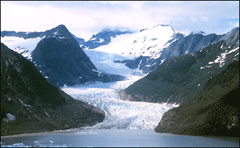Gorilla of Sea Level Rise
Air Date: Week of February 2, 2007

Glaciers like this in Greenland are melting and contributing to the rise in sea level. (Courtesy of the NOAA Photo Library)
The Intergovernmental Panel on Climate Change released a new report on the state of scientific knowledge on climate change. But some say the scientists who wrote the report were overly conservative in their predictions, particularly those for sea level rise. NASA scientist James Hansen tells host Steve Curwood why melting ice sheets could lead to rising sea levels and global catastrophe.
Transcript
CURWOOD: From the Jennifer and Ted Stanley Studios in Somerville, Massachusetts - this is Living on Earth. I’m Steve Curwood. The newest consensus statement of the thousands of scientists in the Intergovernmental Panel on Climate Change says there’s little doubt that the earth will be a much hotter place by the end of the century.
The pronouncement is the result of five years of collaborative work assessing what lies ahead for our warming planet. But some of the world’s leading climate experts say there is a glaring omission regarding another key impact of global warming, sea level rise.
The panel predicts a sea level rise of about a half a meter, or roughly 18 inches, over the next century. But NASA scientist Dr. James Hansen has just written an article in the Journal Science asserting, among other things, that this estimate may be far too low. Dr Hansen joins us now. Welcome to Living on Earth.
HANSEN: Glad to be here.
CURWOOD: And we should probably point out that you are expressing your own opinions here not those of NASA, correct?

James E. Hansen (Courtesy of The Goddard Institute for Space Studies)
CURWOOD: So in your article in Science you looked at what past Intergovernmental Panel on Climate Change reports predicted. What did you find?
HANSEN: Well, we looked at carbon dioxide how the rate of growth of carbon dioxide, the change of global temperature, and the change of sea level. And contrary to what critics have often said, IPCC has not overstated or overestimated those changes. The changes of carbon dioxide have been very accurate. Temperatures actually increased somewhat faster than projections. And sea level has increased notably faster than the prior estimates by IPCC.
CURWOOD: So with that in mind how should we view predictions from this latest IPCC assessment? What did the report leave out or underplay from your view?
HANSEN: Well I think that there is a natural reticence which may derive from the scientific method which says you should be skeptical. You should check all sides of a story and before you make a very strong conclusion. The difficulty here is that I think we have very limited time to get on a different path with our energy use and greenhouse gas emissions or we’re going to end up with unstoppable problems in the future. And I would have preferred an even clearer statement about the dangers of future sea level rise if the ice sheets begin to disintegrate. And I think that a business as usual scenario will guarantee future disintegration of West Antarctica and parts of Greenland.
CURWOOD: So your concern about the chance of loss of large sheets of ice and the considerable impact that that could have on sea level rise is echoed by, um, Ohio State University scientist Lonnie Thompson and he says that those issues are gorillas in the room that the IPCC isn’t paying as much attention to as he thinks it ought to.
HANSEN: Well that’s a very good point because IPCC addresses a lot of things but there are a small number which deserve very great attention. And this, I think, is the number one item just because of the inertia of the system. If we get it started it will become very difficult to stop it, perhaps impossible to stop it.
CURWOOD: Well, how do scientists relay the risk there when there is frankly a lot of uncertainty about what might happen?
HANSEN: Well, you know we do have a lot of information available to us both from paleoclimate; the history of the earth and how ice sheets responded in the past and also the new data from satellites, and on surface measurements on the ice sheets which shows that there are processes beginning to happen there, exactly the processes that we’re afraid will accelerate. The last time a large ice sheet melted sea level went up at a rate of five meters per century. That’s one meter every 20 years. And that is a kind of sea level rise, a rate which the simple ice sheet models available now just cannot produce because they don’t have the physics in them to give you the rapid collapse that happens in a very nonlinear system.

Glaciers like this in Greenland are melting and contributing to the rise in sea level. (Courtesy of the NOAA Photo Library)
CURWOOD: Could you explain what you mean by a nonlinear event?
HANSEN: Well, it’s one in which the response begins slowly but you reach a certain point and suddenly things collapse. So you get a very rapid change. And you can imagine that in the case of large ice sheets. There are several processes that contribute to more rapid loss of ice. As you have melt on the surface of the ice sheet it descends through holes and crevasses to the surface and lubricates the base so that the ice sheet begins to move faster. There’s ice at the edge of the continent, both Greenland and especially West Antarctica, which holds back the ice streams but as the ocean warms and those ice shelves melt that’s like taking the cork out of a bottle and stuff can come out much more rapidly. And even as the ice sheet begins to decrease in size the surface lowers to a lower altitude where it’s warmer and so it melts faster. So you get these multiple positive feedbacks and then you get a sudden collapse and sea level goes up very rapidly. We’re going to guarantee that that happens eventually. If we get warming I would argue of more than 1 degree Celsius additional above that of year 2000.
CURWOOD: Now the present IPCC physical assessment has a center point of about 3 degrees Centigrade increase in temperature.
HANSEN: Yeah so that’s inconsistent with the numbers that they gave for sea level. Now IPCC could not estimate the ice sheet contribution because it is a nonlinear problem and they don’t know how to do it. Ah, but I think they should warn people more strongly about that danger because I think it’s the greatest danger that humanity faces in the global warming problem.
CURWOOD: Professor Hansen how do you see this report affecting policy? What do you expect to happen among policy makers now that this latest assessment is out?
HANSEN: Well, I think it will have a very positive effect. I think there’s already movement among policy makers and there’s a better understanding of the public. Things are moving in the right direction and I think this could give an added impetus to that. The thing that we need to guard against is ineffective incrementalism. What we need is strong actions not some weak actions that slow down the growth rate a bit. We’ve got to get on a path where emissions are actually decreasing.
CURWOOD: Dr. James Hansen is director of the NASA Goddard Institute for Space Studies. Thank you so much sir.
HANSEN: It’s great to be here.
Links
Living on Earth wants to hear from you!
Living on Earth
62 Calef Highway, Suite 212
Lee, NH 03861
Telephone: 617-287-4121
E-mail: comments@loe.org
Newsletter [Click here]
Donate to Living on Earth!
Living on Earth is an independent media program and relies entirely on contributions from listeners and institutions supporting public service. Please donate now to preserve an independent environmental voice.
NewsletterLiving on Earth offers a weekly delivery of the show's rundown to your mailbox. Sign up for our newsletter today!
 Sailors For The Sea: Be the change you want to sea.
Sailors For The Sea: Be the change you want to sea.
 The Grantham Foundation for the Protection of the Environment: Committed to protecting and improving the health of the global environment.
The Grantham Foundation for the Protection of the Environment: Committed to protecting and improving the health of the global environment.
 Contribute to Living on Earth and receive, as our gift to you, an archival print of one of Mark Seth Lender's extraordinary wildlife photographs. Follow the link to see Mark's current collection of photographs.
Contribute to Living on Earth and receive, as our gift to you, an archival print of one of Mark Seth Lender's extraordinary wildlife photographs. Follow the link to see Mark's current collection of photographs.
 Buy a signed copy of Mark Seth Lender's book Smeagull the Seagull & support Living on Earth
Buy a signed copy of Mark Seth Lender's book Smeagull the Seagull & support Living on Earth

